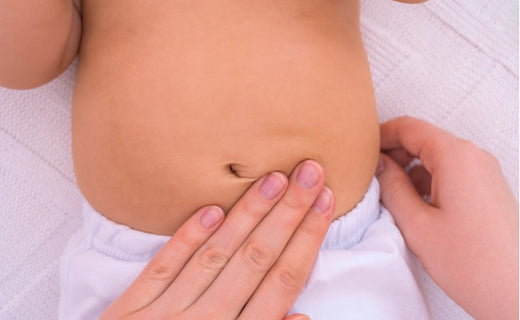

One of the biggest concerns mums have in their journey of motherhood is baby digestion. If you notice your baby experiencing constipation, diarrhoea, flatulence and other issues related to his/her bowel movement at the age of 1 onwards, this has to do with digestive health. Here are six things you need to know about baby digestion so you can help ease his/her discomfort and make bowel movements more regular.






Baby Digestion Tip #1: Check for consistency, in addition to frequency
Many moms make the mistake of counting how many times their baby passes stool in a day to determine if they are suffering from constipation, diarrhoea or other baby digestion problems. However, this is a common misconception. To know if your baby is suffering from constipation or diarrhoea, you need to look at a combination of the colour and consistency of the stool1, along with the frequency. Even if your baby only passes stool once a day, and if his/her stool is too hard, then he/she is constipated. If it is too watery, then they are most likely suffering from baby digestion issues such as diarrhoea. Your baby has normal bowel movement if their excrement is soft, easy to pass and does not require too much force1.
Baby Digestion Tip #2: Stretching does not cause diarrhoea
It’s a common misconception to think that the rapid growth of a 1-year-old is responsible for diarrhoea or influences baby digestion. Additionally, your baby’s activities—learning how to lie on their stomach, sitting, and for older children - standing up and walking - won’t cause bowel movement issues.
If your baby has diarrhoea during this time, it can be a sign of intestinal infection. This is probably due to them being able to reach out and touch things around them. Putting their hands in the mouth is one way of ingesting germs and pathogens that cause stomach and digestion issues. It is very important to clean everything around your baby, especially areas they may venture out into, at this stage.
Another possible cause of diarrhoea is a change in diet. As food intolerances and/or allergies can cause diarrhoea, it is important to observe what changes have been made to the food and drink introduced to monitor baby’s digestion. It is also important to introduce only one new food or drink at any one time, so that the cause of the intolerance or allergy can be easily identified.
Watch for warning signals including drier than usual diapers and excessive sleepiness, as these baby digestion signs may indicate a need for medical attention.
Baby Digestion Tip #3: Passing gas is normal
If you notice that your baby is passing gas or burping a lot, don’t be alarmed. Where baby digestion is concerned, it’s completely normal for toddlers to have gas. Common causes of gas and bloating in babies include the following2:
-
Swallowed air: Swallowed air while drinking and eating makes its way through a baby’s digestive system and is released through the anus as gas. Excessive swallowing of air can cause hiccups.
-
Varying food and beverages: Different solid foods and drinks contain varying gas levels, and changes in a baby’s diet can cause the onset of gas.
-
Lactose intolerance: Babies who cannot easily digest lactose (natural sugar found in dairy products) can experience gas and bloating.
So the next time you see your baby passing bubbles, know that it’s a perfectly normal part of baby digestion for a child above the age of 1 year. It will go away as your baby’s digestive system continues to develop and produce more gastric juice.
Baby Digestion Tip #4: Turning red while defecating does not mean pain
Do you notice your baby turning red whenever they pass a stool? That’s not necessarily a bad thing or a baby digestion problem. They tend to strain excessively since they do not yet know how to defecate slowly. This causes the redness in their face. You can help by massaging their stomach clockwise to facilitate bowel movement.
What you need to watch out for is marble-looking stool3. This indicates constipation. It is most likely a cause of discomfort for your baby. Check for blood in the stool too. This could mean your baby has a tear in the anus, also known as anal fissure. If your baby has not had any bowel movement in a few days, he/she may be experiencing discomfort due to baby digestion issues such as constipation. In such cases, you should consult your paediatrician before giving your baby any medication3.
Baby Digestion Tip #5: Changes in their diet can help facilitate digestion
At the age of one year, your baby’s digestion would already be accustomed to consuming solid foods. And during this stage, it is only natural to try out new food recipes to provide your baby with sufficient nutrition - a crucial component in baby digestion. As your baby’s diet changes, so will their digestion and bowel movement. Some babies may experience constipation or diarrhoea at this stage. It is imperative that only one type of food is provided to the baby so as to identify and eliminate any allergy causing foods. A good rule of thumb at this stage is to feed one type of food over a span of 3-5 days which will serve as the observation period4.
Introducing more fruits and fibre to their diet5 will help to facilitate bowel movement, improve baby digestion and help prevent constipation. If your baby experiences diarrhoea, it is important to make sure they stay hydrated.
Baby Digestion Tip #6: Benefits and techniques of baby tummy massage
Help your baby unwind and release stress from daily stimuli, irritation, gas, colic and digestive issues, by way of massages. Daily massages help foster social, emotional, and cognitive development in your little bundle of joy. Other advantages of massages include strengthening of overall musculature, circulation and digestion with the added benefit of promoting a good night’s sleep6.
If your little one has gas or colic that is causing distress and pain, and if you are willing to try massages to help him or her feel better, here are a few tips to relieve the discomfort with baby tummy massages.

Baby tummy massage technique in a snapshot6
Clock hands.
- Picture a clock face on your baby's belly.
- Start at 7 or 8 o'clock, gently press and slide your hands clockwise in a half-moon shape from left to right.
- The hands should move in tandem.
Paddling.
- Gently press in at the rib cage and slide down the length of your baby's belly
- Use the long, broad, pinky-side of your hands horizontally over the baby's belly.
Fulling.
- Above the abdominal button, place your two thumbs flat across the belly of your baby.
- Slide the thumbs apart while gently pressing in.
I love you.
- Trace the initial I beginning on the right side of your baby's belly button.
- Trace the letter L sideways, beginning in the upper left corner of the baby's abdomen, going across to the right, and ending there.
- Start at the bottom left corner of the baby's belly and trace up, across the body above the belly button, and back down the right side to create an inverted U shape.
- All the while saying I love you, to your baby.
Moonwalking.
- Starting on the left side, just above the belly button, move your pointer and middle fingers slowly across the baby's torso to the right side.
For more information on baby massage techniques, check with your doctor on certified online portals for hands-on assistance.
How to prep your baby for a massage6
Understand your baby’s moods.
- Asking for permission so that your baby may grant you the time for a massage.
- Making eye contact with a comforting tone of voice and steady hands will help you achieve this.
Pick a time of day or night that makes your baby happy.
- The best time of day for a massage and how often to give it should be determined by your baby.
Prep the place of massage with all things that calm your baby.
- Place the baby in a warm, quiet spot on a soft towel with soothing music
- Whispering reassurances will help your baby settle down and enjoy the spa session.
Use an oil or lotion.
- This helps make it a more comfortable and enjoyable experience
- Pay attention to the components that need to be specifically favourable to the baby’s skin.
Download the Enfamama A+ Club mobile app to access a comprehensive Baby Poop Tracker to better understand your baby’s digestion based on detailed poop analysis.
Expert Resource:
Dr. Raymond Choy Wai Mun
(MCR 18097A)
MBChB (UK), Aviation Medicine (Singapore)
REFERENCES:
- “Constipation and diarrhea in newborns” About Kids Health. Accessed October 14, 2020: https://www.aboutkidshealth.ca/Article?contentid=458&language=English
- “Gas, Bloating and Burping.” C.S. Mott Children’s Hospital. Accessed October 14, 2020: https://www.mottchildren.org/health-library/gas
- “Symptoms and Causes of Constipation in Children.” National Institute of Diabetes and Digestive Kidney Diseases. Accessed August 23, 2020: https://www.niddk.nih.gov/health-information/digestive-diseases/constip…
- “How long to wait between introducing new baby foods.” Parents.com. Accessed October 14, 2020: https://www.parents.com/recipes/scoop-on-food/how-long-to-wait-between-….
- "Guide to Common Infant Conditions.” Health Hub—Ministry of Health Singapore. Accessed August 23, 2020: https://www.healthhub.sg/live-healthy/1954/guide-to-common-infant-condi…
Some materials are from Asst. Prof. Dischi Lumphikanon, Pediatrician, Neonatal and Perinatal Department of Pediatrics, Faculty of Medicine Vajira Hospital - Healthline. Baby massage for gas. Medically reviewed by Karen Gill, M.D. — Written by Catherine Crider on June 29, 2020: https://www.healthline.com/health/baby/baby-massage-for-gas-2






